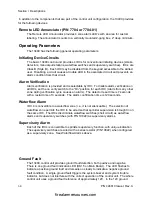
13400 Owner’s Manual
P/N 446613 Issue I Rev. A
iv
Control Unit Limitations
This control unit will not show an alarm condition without compatible initiating
devices (smoke detectors, etc.) and notification devices (horn, lights, etc.)
connected to it. Electrical ratings of the initiating and notification appliances must
be compatible with the electrical ratings of the control unit and must be properly
interconnected. The wiring used for interconnection must be large enough to carry
the total current by all appliances without excessive voltage drop.
This control unit must be connected to a dedicated primary electrical source that
has a high degree of reliability and adequate capacity for this control unit. The only
means of disconnecting this power source shall be available only to authorized
personnel and clearly marked “Fire Alarm Circuit Control.”
This control unit must also have connected to it, a battery set (24V) that has enough
capacity to properly operate the system for 24 or 60 (depending on system type)
hours standby and 5 minutes alarm per NFPA 72 (chapter 1). These batteries do
lose capacity with age. Batteries must be replaced when they fail to provide the
control unit with the required standby and alarm power or after 4 years, whichever
happens first. These batteries must be checked for performance at least two (2)
times per year or more often if local requirements dictate it.
Fire alarm control units cannot last forever. Even though this control unit was made
to last for the expected life of the Fire Alarm Systems, any part could fail at any
time. Therefore, a regular test program should be followed and documented to
make sure that each part of the system is tested as per Chapter 7 of NFPA 72 or
more often if dictated by local code requirements. Units that have malfunctioned
must be replaced or repaired immediately by factory authorized service personnel.
Note: This control unit is designed to show an alarm condition when the initiating
devices connected to it detect specific conditions. These conditions may or may not
represent a life threatening condition (i.e., burnt toast may not be a life threatening
condition but may cause an initiating device to indicate an alarm condition). Also,
evacuation of a building or area may unnecessarily subject individuals to an
unnecessary hazard. Therefore, it is most important that building owner, manager
or representative promulgate, distribute and/or post instructions describing steps to
be taken when the fire alarm control unit signals an alarm condition. These
instructions should be developed in cooperation and conformance with
representatives of the local authority having jurisdiction.
As a backup or precautionary measure, it is strongly suggested that one of these
steps should be to notify the local fire department of an abnormal condition even
where the city tie option (or similar device) is included in the system.
firealarmresources.com


























